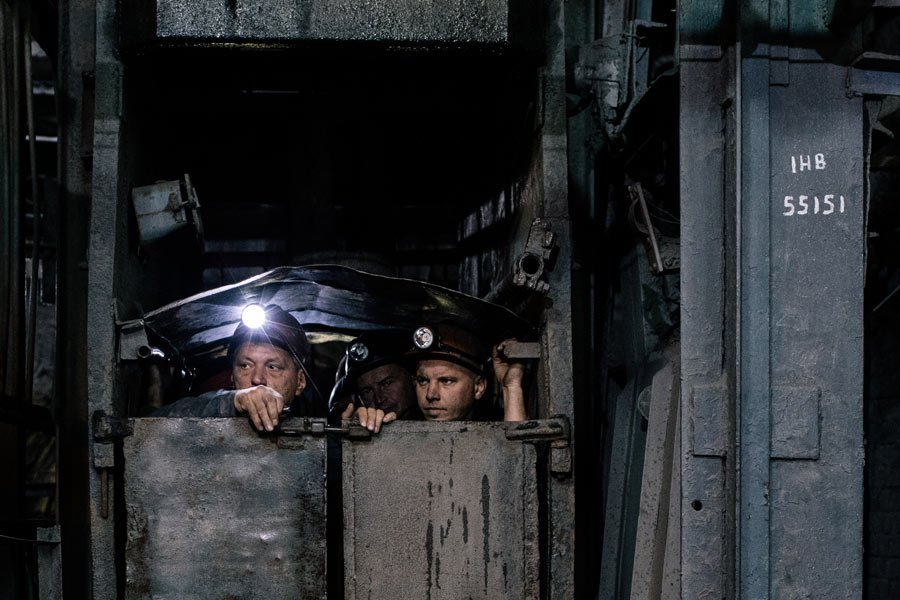As Russia’s invasion of Ukraine enters its second year, coal mining towns are not only on the front line of our country’s resistance but also at the heart of our vision to rebuild a fairer, safer and greener Ukraine, writes Anna Ackermann.
Anna Ackermann is board member at the Ukrainian NGO Ecoaction – Centre for Environmental Initiatives.
Once home to 14,000 people, the small coal-mining town of Vuhledar in the Donetsk region of eastern Ukraine lies in ruins. For months, the town has been the focus of successive Russian assaults.
Prior to the war most of its residents worked in nearby coal mines and factories, but like many of Ukraine’s occupied and frontline coal towns, energy, water and other critical infrastructure has been destroyed, and the mines irreversibly flooded.
As the battle for Vuhledar intensifies, it’s uncertain when its residents will return. But when they do, there is an enormous opportunity for the city built solely to produce coal to be completely replanned around renewable energy generation and other sustainable economic activities to future-proof Ukraine, contribute to national and European security, and further Ukraine’s integration with the EU.
In 2019, Vuhledar became one of nine Donetsk region coal towns to start working together to plan their transition beyond coal.
Local authorities realised that the industry was in terminal decline, and consensus built around the need to develop strategies to carefully manage the closure and rehabilitation of the mines and ensure alternative education, employment and safety nets for workers.
Sadly, much of this planning has now been torpedoed with Donetsk region coal towns like Toretsk, Selydove and Pokrovsk experiencing heavy shellings while their counterparts in the Luhansk region have been occupied.
But the determination to deliver a just transition remains. It will be much faster than originally planned. But with a clear vision and outside support, these communities will be able to rapidly rebuild a better, more secure and sustainable future from the ground up.
‘Fast recovery’ meets long-term reconstruction
Russia’s destruction of Ukraine’s soviet-era energy infrastructure has made the strategic vulnerability of centralised energy systems clear for all to see. Power outages are daily, and the risk of a serious nuclear incident still looms large as Russian forces occupy Europe’s largest nuclear power plant.
The poor energy efficiency of Ukraine’s buildings and transportation systems has also proven a drag on its war effort, hampering logistics, and weighing on people enduring a cold, dark winter.
The incredible efforts of Ukrainian engineers to rapidly restore vital services are now a thing of legend.
But these extraordinary feats, combined with the EU’s recent announcement of a one billion euro “fast recovery” fund have opened the door to a positive vision of a modern, clean, and renewable-powered Ukraine.
There are already a number of inspiring examples of how green ‘fast recovery’ can inform long-term reconstruction.
The Horenka village hospital on the outskirts of Kyiv was crippled when a Russian shell landed metres from the facility, blowing out the windows and cutting power supplies.
Insufficient electricity during the cold winter caused the hospital’s heating system to fail, and doctors and nurses operated in extremely challenging conditions.
But it has now been fitted with a heat pump (reducing heating costs by 80%) and solar panels (covering ~60% of the building’s energy consumption) allowing patients to receive around-the-clock care despite grid outages.
In Zhytomyr Oblast, another clinic has been fitted with solar panels to power ventilators for patients in intensive care. In both cases, replacing inefficient, centralised energy with green localised, renewable alternatives has increased energy security, reduced costs and slashed CO2 emissions.
Investing in our shared European future
Importantly, the use of innovative technologies isn’t reserved for one-off, small-scale interventions.
Ukraine has embraced emerging technologies to improve the country’s effectiveness on the battlefield, and the government is now looking to modern renewable energy systems to power the country’s reconstruction – deepening its relationship with the EU by contributing to the bloc’s energy security and decarbonisation goals.
Importantly, this vision is shared in the EU. Commission President Ursula von der Leyen and German Chancellor Olaf Scholz have both called for a “Marshall Plan” for Ukraine underpinned by the principles of the EU’s Green Deal.
Back in November, the director of the International Energy Agency Fatih Birol wrote in the Economist that he believed Russia’s invasion of Ukraine is “driving powerful structural changes that are set to accelerate the transition to clean energy”.
Nowhere is this more true than in Ukraine itself, where a green recovery is now a Ukraine–EU shared mission. Russia’s invasion of Ukraine exposed the enormous geopolitical and climate security threats Europe gave rise to by sourcing cheap fossil energy from an aggressor state.
European leaders are working to quickly eliminate Russian fossil fuels from their energy systems, but this alone will not be enough in the long term.
Fossil fuel use is driving war, the cost of living crisis, and climate change. Decarbonising Europe’s economy completely is the only way to fairly and truly solve all these issues at once.
Fortunately, the benefits of cheap, fossil-free, homegrown energy are increasingly obvious, and 87% of EU citizens want more investments in renewable energy.
Ukraine has long been referred to as the ‘breadbasket of Europe’, now we must ensure ‘green energy superpower’ is added to that moniker.
By Anna Ackermann
Source: euractiv.com
Photo by Niels Ackermann LUNDI13

